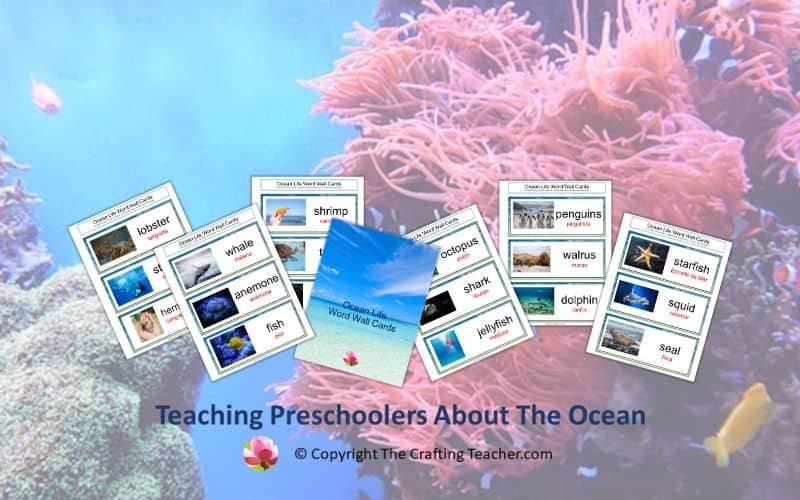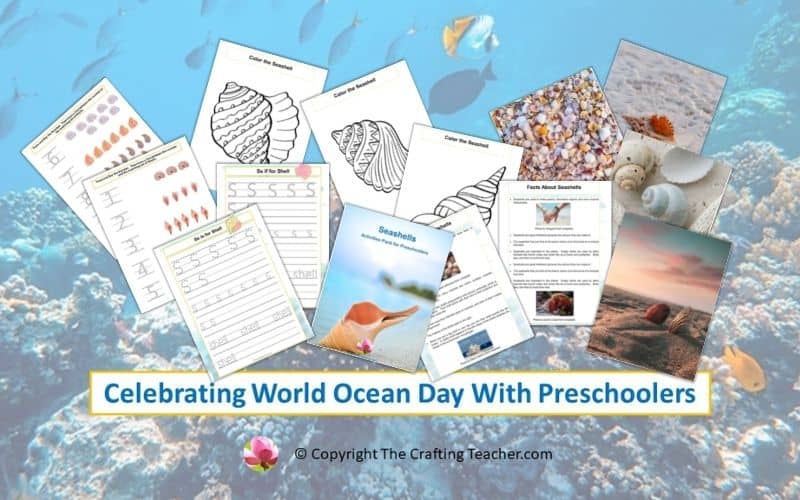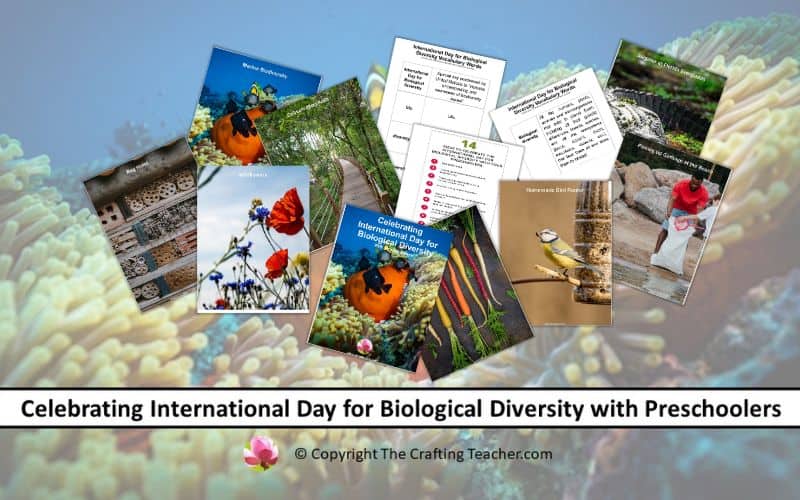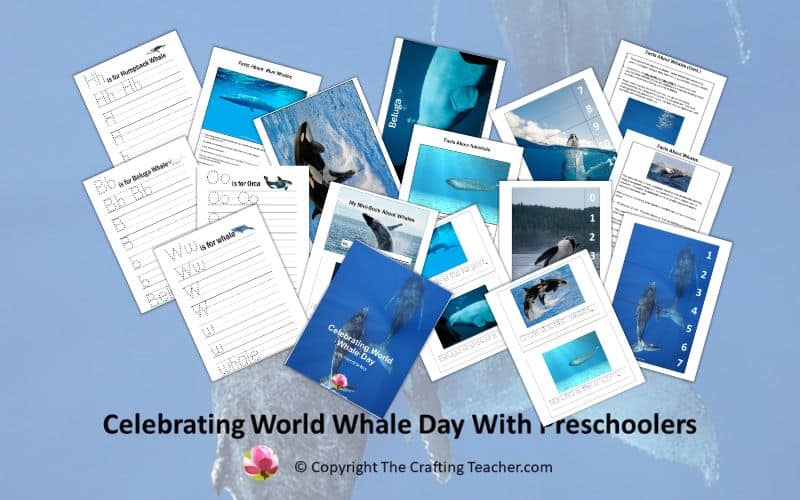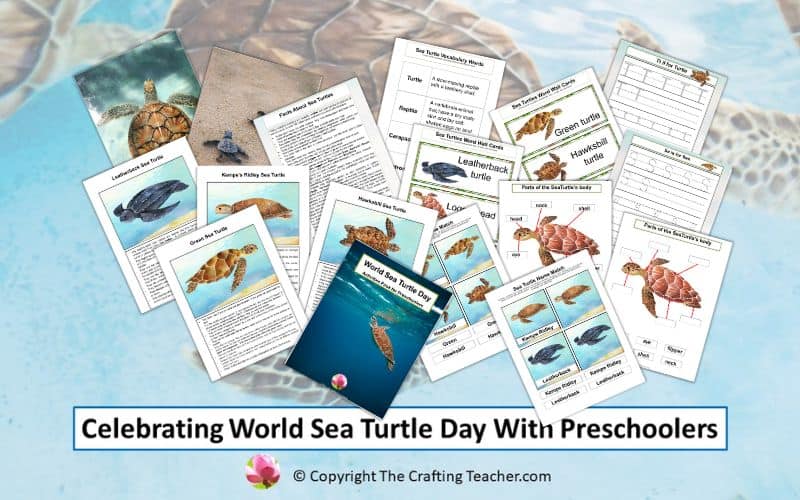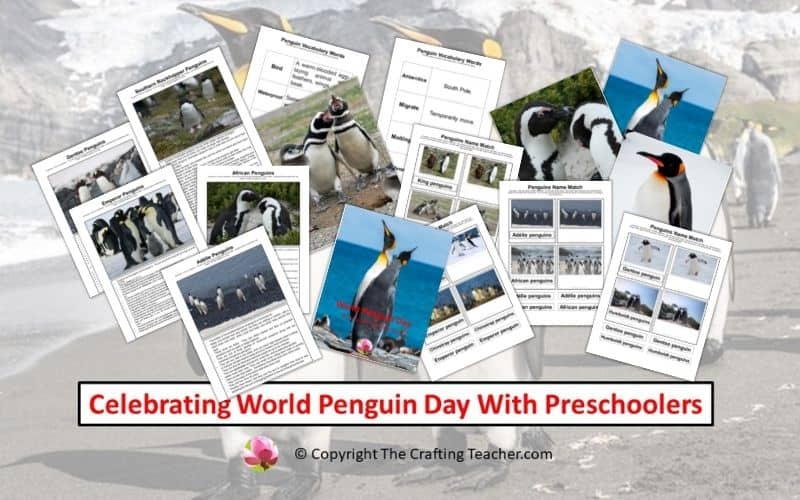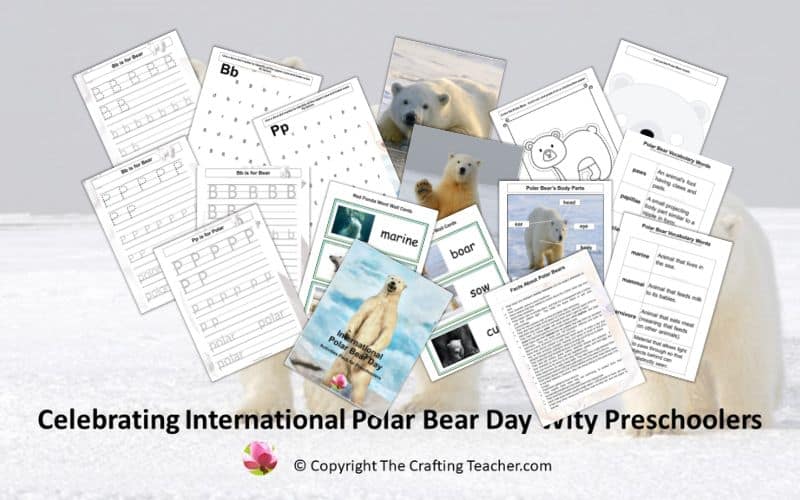Teaching Preschoolers About the Ocean
Affiliate Disclosure: “This post contains affiliate links, which means I receive a small commission, at no extra cost to you, if you make a purchase using those links.”
The ocean is one of our planet’s most beautiful, enjoyable, engaging, and mysterious places. We can teach our preschoolers so much about it that we could use this theme to cover a considerable portion of the year.
Even when you can teach your preschoolers about the ocean any time of year by itself or in combination with related themes like the beach or sea life, it is a great theme to use in the celebration of World Ocean Day this June 8th, mainly because the end of the school year is approaching. It can also be a great theme to start the summer with.
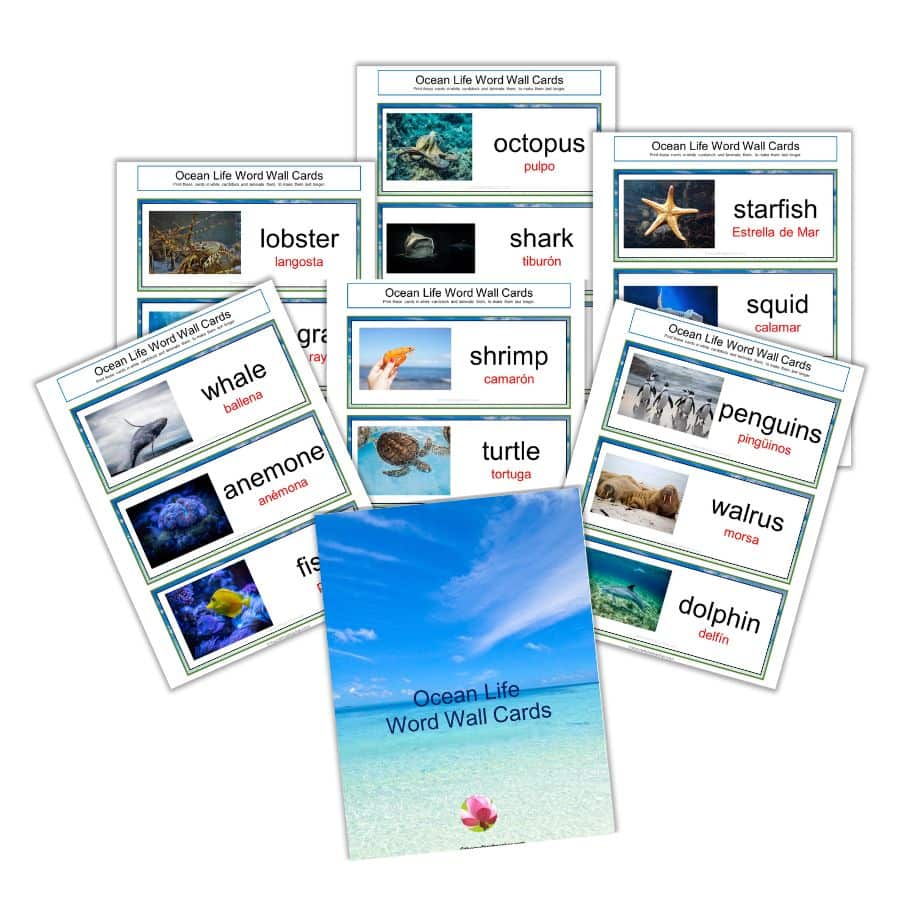
At the end of this post, you will find a free Ocean Life Word Wall Cards pack to teach about the ocean. It includes six pages with three words, each accompanied by real pictures, for 18 ocean animals.
Importance of Teaching Preschoolers About the Ocean
Preschoolers must learn essential facts about the ocean, recognize and identify different kinds of ocean life, and understand the importance of keeping the sea free of trash, especially plastic. The ocean and its inhabitants need our help desperately, and most importantly, our survival depends on having a healthy ocean.
We can start by asking our children questions about the ocean to learn what they know, are curious about, and need to learn. Some of the things I consider vital for them to know are:
- What are some of the differences between a marine mammal and a fish?
- Which are some of the most essential predators that live in the ocean?
- What gifts does the ocean give us?
- How pollution in the ocean can affect ocean life and us?
- Are the ocean and the sea the same thing?
- Why is the ocean salty?
- Is there one huge ocean or several of them?
- What is a coral reef?
- What type of ocean life can we find in the ocean?
Even when some of your children might not be able to get to the natural ocean or even a beach, teaching about it is critical and can be fun. If you haven’t started, use this opportunity to teach your kiddos about the ocean and encourage them to learn how to protect it.
Essential Facts about the Ocean
- The ocean’s most significant gift is half the oxygen every living creature on Earth needs to breathe. Algae and plankton produce oxygen through photosynthesis, which is disrupted by pollution, especially plastic pollution. The ocean also absorbs about 30% of humans’ carbon dioxide (CO2) into the atmosphere.
- The ocean also provides us with food, decorations, and many ingredients found in different products, such as medications, salad dressing, and many other products used in everyday life. These products are developed with chemical compounds and living creatures in the ocean.
- According to the NOAA Global Ocean Monitoring and Observing Program, oceans cover more than 71% of our planet’s surface and almost 97% of Earth’s water.
- There is only one big ocean in the world, but scientists divided it into five different sections: the Atlantic, the Indian, the Pacific, the Southern, and the Arctic oceans. The Pacific is the largest, the Arctic is the smallest and coldest, the Indian is the warmest, and the Southern is the youngest.
- The ocean’s water is full of salt, which comes from rocks on land that get eroded by rainwater, which is slightly acidic and dissolves in seawater, and openings in the seafloor. The ocean provides humans with table salt. To collect it, humans create shallow pools of ocean water. When the water evaporates, the salt crystals are left behind and ready to be harvested.
- A sea is part of the ocean, not something different, and it’s usually surrounded by land on several sides. The waters are called the Caribbean Sea (a portion of the Atlantic Ocean that is between North, Central, and South America, up to the North of the Greater Antilles to the East of the Lesser Antilles); the Baltic Sea (found in Northern and Central Europe); and the Mediterranean Sea (found between Africa and Europe).
- The ocean floor is not entirely flat. It has many levels. Some areas are so deep that it has been impossible for scientists to reach the bottom. Around the continents, the ocean floor is shallower, and as it goes farther, it becomes more profound. These deep parts are called basins. It also has flat plains, deep cracks called trenches, underwater lakes and rivers, and mountains, including the longest mountain on the planet, with 40,389 miles in length.
- The Pacific Basin is named the Ring of Fire because it is prone to volcanic activity and earthquakes. This basin houses more than 450 volcanos.
- The Mariana Trench is the deepest part of the Pacific Ocean, almost seven miles deep.
- Ocean waters are always moving. These movements are called currents, and they are caused by winds, earthquakes, storms, gravity, temperature, and salinity variations. When the currents are warm, they produce warm weather and rain; when they are cold, they create a dry climate.
- The ocean plays a vital role in the planet’s climate and weather. When water evaporates, this moisture condenses and forms clouds, which release this moisture as rain. This is called the water cycle. When the sun warms the water, the ocean releases that heat to the atmosphere, which balances the temperature on the planet by absorbing heat in the summer and releasing it in the winter. Without this process, Earth, in general, will be extremely cold.
- Winds also produce waves on the surface of the ocean. The long-period waves caused by the forces exerted by the moon are called tides. The tides progress toward the coastlines. When the tides advance, the furthest on the shoreline is high tide, and when they recede to their furthest extent, it is called low tide.
- The ocean’s pressure increases as it goes more profound, and scientists still have not been able to create the appropriate technology to go that deep. Because of this, more than 80% of the ocean is still a mystery.
- The ocean has different habitats or natural homes where thousands of species of animals, plants, and other organisms live, such as the coastal (closer to the shores) and the open ocean.
- Among those, two of the most diverse habitats on Earth are kelp forests and coral reefs. Kelp forests are built by a large type of algae called seaweed. Coral reefs are built by tiny animals called polyps. The largest coral reef is the Great Barrier. It is so big that it can be seen from space. Both habitats provide food and shelter to hundreds of different ocean animals.
- The ocean is home to the most giant animals on the planet, the Blue Whale, which is as long as two school buses, and some of the smallest ones, the zooplankton, which can only be seen using a microscope. The deep ocean is also home to bioluminescent animals, called like that, because they produce their light.
- The main predators in the ocean are the orcas or killer whales. They hunt everything they can, from great white sharks to other whales. They hunt in groups, and no other known animal in the ocean can take them down.
- Oceanographers are scientists who study the ocean. They study the plants and animals that live there, monitor the quality and movement of the water, observe the changes in the basins and ocean floor, trying to devise solutions to keep it healthy.
- Marine Biologists are scientists who study marine animals, how they live, and how they interact in their ecosystem.
- Marine mammals and fish are not the same. The main difference is that marine mammals (such as whales and dolphins) have lungs, breathe air from the surface, and feed milk to their babies, while fish (such as sharks) have gills that they use to get oxygen from the water.
- The ocean is in trouble. Millions of plastic pieces are dumped into the sea daily, causing 10% of all dead ocean animals on beaches and floating worldwide. If the ocean dies, we die. We must learn what is causing this situation and do something about it.
Ocean-related Activities You Can Do
You can do many ocean-related activities with your preschoolers to help them understand the ocean better and the creatures that make it their home. These are some ideas:
Math
- Have them organize ocean animal figures from more minor to more extensive and vice versa.
- Have them count ocean animal figures or seashells.
- Invite them to measure ocean animal figures using a ruler or connecting cubes.
- Write numbers on seashells and have children match them with plastic numbers, or copy them using pencils, crayons, markers, or tracing the numbers in sand.
- Serve Goldfish crackers for a snack and have the children count how many they have or sort the crackers by color.
- Gather a group of different types of animals, and have the children sort out which live on land and which live in the ocean.
Science
- Have them observe sea shells with magnifying glasses and sort them by type, color, or texture.
- Talk about the differences between ocean mammals, reptiles, and fish.
- Start a classroom aquarium with tropical fish or tiny turtles, involving the children in its setup. Talk to them about the habitat you are creating, how you should feed the animals, and why you should keep it clean.
- Have them experiment with which items float or don’t, using ocean animals, seashells, toy boats, and other ocean-related items.
- Explain the importance of keeping plastic garbage out of the ocean.
- Show them what oil spills can do with an experiment: Place water in a container. Add oil and natural feathers. Let it sit for a few minutes. Children will notice how the oil sticks to the feathers.
- Talk to them about the differences between fresh water and salt water. Have them taste a drop of salty water.
- Explain what an ocean is and what part of the ocean is considered a sea.
- Explain that whales are the animals that produce the loudest sound (louder than a jet engine or a launching rocket).
- Explain that whales use their blowhole to breathe, and encourage your children to experiment with this breathing by taking a deep breath, holding it for a few seconds, and then releasing it.
Art
- Use paper plates and cut out ocean items or stickers to create underwater art.
- Make an ocean on a bottle using sand, mini shells, mini ocean life, and blue-colored water.
- Provide a big blue paper and invite your students to stamp, draw, paint, and glue seaweed, fish, shells, and other ocean-related items to make a class mural.
- Make jellyfish crafts. Have your children use a dropper to drop diluted tempera paint on top of coffee filters or small paper plates. Once dry, let them glue streamers on the borders. Then, hang them from the ceiling.
Dramatic Play
- Add an ocean-themed shower curtain, ocean-related books, ocean animals, sea shells, costumes, snorkels, swim fins, and other related items, and invite the children to pretend to be ocean animals or mermaids.
- Create a beach area with beach chairs, towels, sand play items, ocean-related books, seashells, beach clothes, flip-flops, hats, empty suntan lotion bottles, sunglasses, toy fishing rods, and toy fish, and invite the children to pretend to be at the beach.
- Invite your children to pretend to build an aquarium by adding a plastic fish tank, mini shells, ocean animals, plastic seaweeds and corals, and other related items.
Block Area
- Add water vehicles, ocean-related books, ocean animals, a blue carpet or sheet, plastic seaweeds and corals, stones, and other items, and invite the children to use them with the blocks to build an aquarium, underwater world, or anything else their imagination allows them to.
Literacy
Print the free word wall cards below in white cardstock, cut them out, separate them, and laminate them for durability. Place them in your word wall and different centers, and use them to do different literacy activities such as:
- Introducing the names of the animals featured in each of them.
- Clapping the syllables in each name.
- Organize them in alphabetical order.
- Introducing or reviewing the name and sound of the first letter.
- Have the children trace the words using a dry-erase marker.
- They can trace the first letters or the entire word on the sand.
- Read ocean-related books to the children and place those books in the different centers.
Sensory
- Create a sensory bin with blue-tinted water or rice (or a blue container), sea shells, plastic ocean animals, sand, and plastic plants.
- Have them use kinetic sand and ocean-related mini molds to make sand sculptures.
- Provide playdough in different colors, rolling pins, mini shells, and ocean-related cutters for the children.
Social Studies
- Talk about some ocean-related jobs people do, such as marine biologists, fishermen, lifeguards, sailors, treasure hunters, and oceanographers.
- Present a globe or a map to show your children the geographic location where you all live: the Great Barrier, the Mariana Trench, the Ring of Fire, and the different sections of the ocean (the Atlantic, the Indian, the Pacific, the Southern, and the Arctic).
- Discuss family names for marine mammals such as bull, cow, and calf.
- Discuss what makes an animal endangered and what we can do about it.
- Compare the ocean to a fish tank or an aquarium.
Other Ideas
- Invite your families to donate items from the ocean (seashells, sand dollars, etc.) and photos from family trips to the ocean.
- Invite special guests (fisherman, marine biologist, oceanographer, aquarium keeper) to come to the class and talk to the children about their ocean-related expertise.
- Organize a field trip to your local aquarium or ocean (beach) for your preschoolers and their families. If this is not possible, watch educational videos with them.
- Organize a beach cleaning trip with your families. This is an excellent opportunity to teach the kids about ocean pollution and the importance of not leaving our plastics on the beach.
Ocean-related Books
There are many good fiction and nonfiction ocean-related books that you can read to your preschoolers. Below are some of my favorites. You can find those books at your local library, used book store, or on Amazon. I added my Amazon links to the titles; clicking on them will take you directly to the Amazon page if you want to purchase some.
Use every opportunity to give them plenty of variety and choices for their different skills and interests, and most importantly, have fun while doing it. The children will pick up on your excitement, encouraging them to stay engaged.
- My First Book of Ocean Animals by Ginger L. Clarke is packed with fun facts and photos that teach kids all about the reptiles that crawl on coastlines, the fish that swim underwater, and so much more.
- What Lives in a Shell? by Kathleen Weidner Zoehfeld is a picture book featuring beautifully accurate illustrations of the many types of shells, inside and out. It offers a fascinating exploration of the many creatures that make a home in a shell.
- A House for Hermit Crab by Eric Carle. This story will teach children that for every friend and adventure left behind, there are new ones just ahead, through the experiences of a hermit crab.
- Ocean Full of Wonders by Anna Smithers is a vibrant, rhyming, educational, and unique picture book that shows the unbreakable bond between people and the ocean. It encourages readers to fall in love with nature and become Protectors of the Ocean.
- Inky the Octopus by Eric Guendelsberger. Based on a true story, this ocean picture book chronicles the adventure that Inky might have taken in his escape to freedom in real life.
- Save the Ocean by Bethany Stahl. This engaging book teaches children about plastic pollution using beautiful and charming illustrations and teaches them a heartwarming lesson about recycling and conservation.
- First Big Book of the Ocean by Catherine D. Hughes. This National Geographic book is an adorable animal reference that includes the sea’s high-interest animals and introduces kids to some of its lesser-known creatures. It uses more than 100 photos to illustrate the profiles, with facts about the creatures’ sizes, diets, homes, and more.
- How to Hide an Octopus and Other Sea Creatures by Ruth Heller. Children will go on a fascinating nature hunt to find the camouflaged octopus, crabs, brilliantly painted tropical fish, and other wonderful sea creatures hidden in the pages of this book.
- The Ocean Alphabet Book by Jerry Pallotta. This first concepts book covers sea creatures from A to Z, introducing children to over twenty-six species that live in the North Atlantic Ocean, using scientifically accurate text paired with fun and detailed illustrations.
- Mr. Seahorse by Eric Carle. This book teaches children about the only male creature on the planet that carries its eggs until they hatch, the seahorse.
- Over in the Ocean by Marianne Berkes. This book is filled with baby animals from the coral reef.
Pin It For Later
If you are in a rush and don’t have time to read the post and download the printable but want to save it for later, pin it to one of your Pinterest boards.
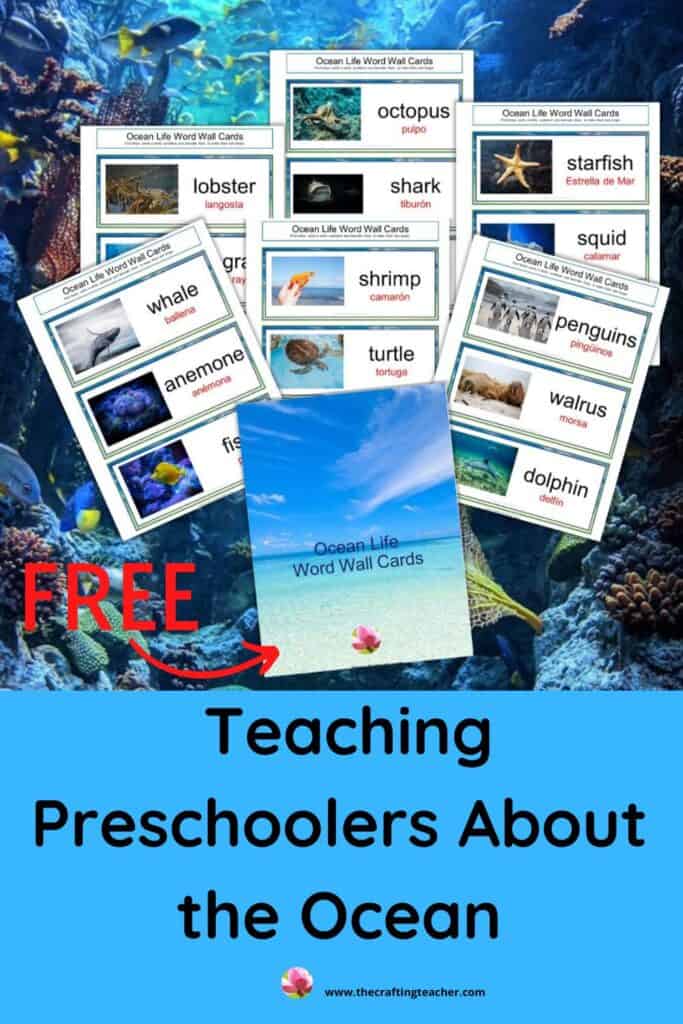
Don’t forget to grab your free Ocean Life Word Wall Cards! Click on the link below for an immediate download, and start using them every day in your classroom.
P.D. I hope you and your preschoolers enjoy this printable and becomes a fun and useful resource for all of you.
Be happy, safe, and creative. I wish you well.
Love,

P.S. Please let me know if you like these ideas and if they worked for you and your preschoolers.

